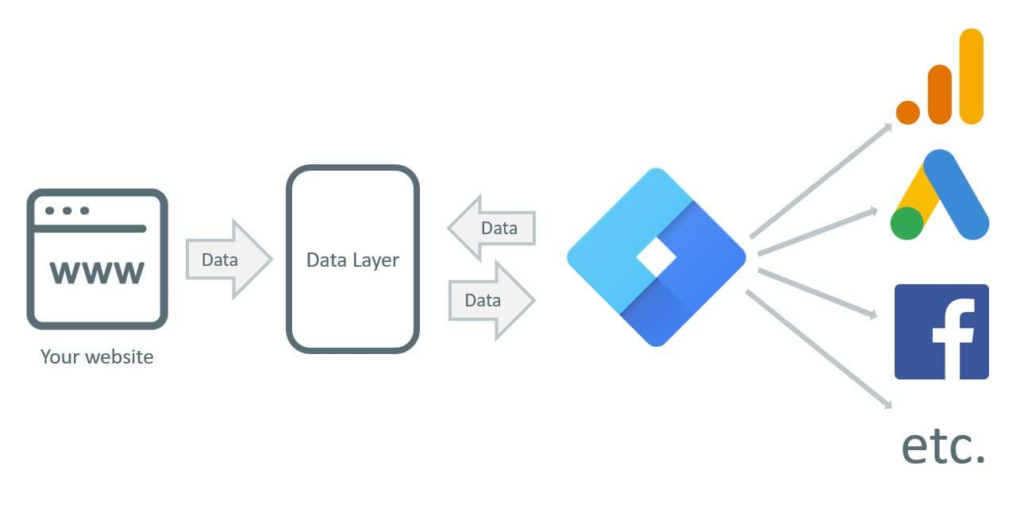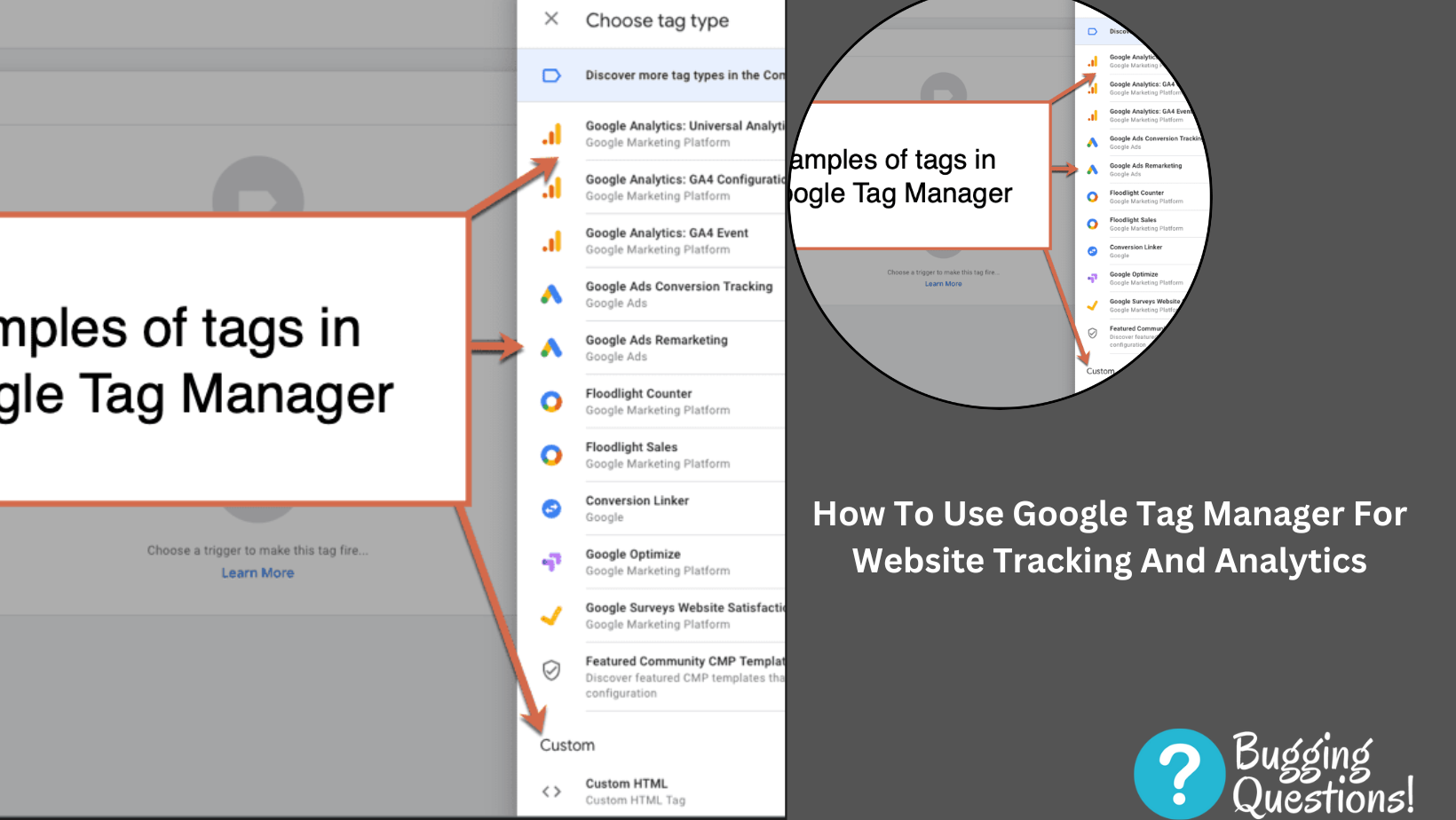How To Use Google Tag Manager For Website Tracking And Analytics: In the ever-evolving landscape of digital marketing, keeping track of website performance and analyzing user behavior is crucial for achieving success online.
That’s where Google Tag Manager (GTM) comes in. This powerful tool allows you to streamline the process of implementing and managing tracking codes and analytics tags on your website, making it an indispensable asset for any website owner or digital marketer.

1. Understanding Google Tag Manager
Google Tag Manager is a free tool provided by Google that simplifies the process of managing various tracking codes, such as Google Analytics, Facebook Pixel, and AdWords Conversion Tracking, among others. Instead of manually adding these codes to your website’s HTML, GTM provides a centralized platform where you can implement, edit, and control all your tags through a user-friendly interface.
2. Setting Up Google Tag Manager
To begin leveraging the benefits of GTM, you first need to create an account. Visit the Google Tag Manager website and sign in using your Google account credentials. Once inside, you’ll need to set up a container. Think of a container as a placeholder for all your tags and tracking codes on a specific website. Provide a name and choose the appropriate platform (web, iOS, Android) for your container.
After setting up the container, you’ll be given a code snippet to add to your website. Place this snippet just before the closing </head> tag on all the pages of your website. This code snippet allows GTM to function properly and manage the tags on your website.
3. Adding Tags In Google Tag Manager
With the setup complete, you can start adding tags to your container. Tags are snippets of code that collect specific data and send it to third-party tools, such as Google Analytics. GTM provides a wide range of built-in tag templates for popular services, making it easy to set up tracking for events like page views, button clicks, form submissions, and more.
To add a new tag, click on “Tags” in the left sidebar of the GTM interface, then select “New.” Choose the tag template that matches your desired tracking type and configure it according to your needs. You can specify triggering conditions to control when and where the tag fires, ensuring that it collects the right data at the right time.

4. Testing And Debugging
Once you’ve added tags to your container, it’s crucial to thoroughly test and debug them to ensure they’re functioning as intended. GTM provides a preview mode that allows you to simulate tag firing on your website without impacting actual user data. This mode enables you to verify that the tags trigger correctly and that the data is being sent to the appropriate analytics tools.
Additionally, GTM’s built-in debugging features can help you troubleshoot issues. The debug console provides real-time feedback, displaying which tags fire on specific events and any errors encountered during the process. Utilizing these tools will ensure that your tracking codes are accurate and effectively capturing the desired data.
5. Leveraging Google Tag Manager For Advanced Tracking
Beyond basic tracking, GTM offers advanced features that allow you to gather more detailed insights into user behavior. Here are a few notable capabilities:
a. E-commerce Tracking: Implementing e-commerce tracking enables you to monitor crucial metrics like transactions, revenue, and conversion rates. GTM simplifies this process by providing pre-configured variables and triggers specifically designed for e-commerce websites.
b. Scroll Tracking: Understanding how users engage with your website’s content is vital for optimizing user experience. GTM offers scroll tracking functionality, which allows you to track how far users scroll on a page and gain insights into their engagement patterns.
c. Custom Event Tracking: With GTM, you can track custom events tailored to your
specific website goals and objectives. Whether it’s tracking video plays, file downloads, or form submissions, GTM enables you to define and track custom events based on your unique requirements.
d. Cross-Domain Tracking: If your website spans multiple domains or subdomains, GTM simplifies the process of tracking user behavior across these different properties. By configuring cross-domain tracking, you can gain a comprehensive understanding of user journeys and interactions between various parts of your online presence.
e. User ID Tracking: GTM allows you to implement User ID tracking, which enables you to associate user activity across multiple sessions and devices. This functionality is particularly valuable for businesses with user accounts or subscription-based models, as it provides a more holistic view of individual user behavior.
6. Optimizing Website Performance
In addition to its tracking and analytics capabilities, GTM can also help optimize your website’s performance. By using GTM to manage your third-party tags, you can prevent slow-loading scripts from negatively impacting your site’s speed and user experience. GTM’s asynchronous loading ensures that tags load in parallel with your website content, minimizing any potential delays.
Furthermore, GTM’s built-in version control and rollback functionality allow you to easily manage changes to your tags and revert to previous versions if necessary. This feature helps maintain stability and reduces the risk of unintended disruptions or errors caused by tag modifications.
7. Enhancing Collaboration And Efficiency
Google Tag Manager is not just a powerful tracking tool—it’s also designed to enhance collaboration and streamline workflows. With GTM, you can grant different levels of access to team members, ensuring that the right individuals have the necessary permissions to manage tags, trigger configurations, and publish changes.
The user-friendly interface of GTM simplifies the process of tag management, eliminating the need for direct involvement from developers. This empowers marketers and website owners to make quick updates, test new tags, and experiment with different tracking configurations without relying on technical resources.

8. Staying Up-To-Date With GTM Resources
Google Tag Manager is constantly evolving, with new features and updates being introduced regularly. To stay current and maximize your utilization of GTM, it’s essential to tap into available resources. Here are a few valuable sources to keep in mind:
a. Official Google Tag Manager Help Center: Google provides an extensive help center with documentation, guides, and tutorials on various aspects of GTM. It covers everything from basic setup and configuration to advanced tracking techniques and troubleshooting.
b. Online Communities and Forums: Engaging with online communities, such as the Google Tag Manager community forum, allows you to connect with other users, share insights, and seek guidance on specific challenges or questions you may encounter.
c. Webinars and Training Courses: Google periodically offers webinars and training courses focused on Google Tag Manager. These resources can provide in-depth knowledge and best practices for leveraging GTM effectively.
9. Conclusion
Google Tag Manager is an indispensable tool for website owners and digital marketers who want to streamline website tracking and analytics. By centralizing the management of tracking codes and tags, GTM simplifies the implementation process and provides valuable insights into user behavior.
From basic tracking to advanced capabilities like e-commerce tracking, scroll tracking, and custom event tracking, GTM offers a wide range of features to help you gather detailed data and optimize your website’s performance. Its collaboration and efficiency-enhancing features ensure smooth workflows and empower non-technical users to take control of their tracking needs.
To fully leverage GTM’s potential, stay up-to-date with official documentation, engage with online communities, and take advantage of available training resources. By harnessing the power of Google Tag Manager, you can gain a competitive edge in the digital landscape and unlock valuable insights to drive the success of your website and marketing
In conclusion, mastering the use of Google Tag Manager is essential for website owners and digital marketers looking to excel in tracking and analytics. By effectively implementing GTM, you can streamline the process of managing tracking codes and tags, gaining valuable insights into user behavior and optimizing your website’s performance.
Remember to set up your GTM container correctly, add the necessary tags, and thoroughly test and debug your implementation. Take advantage of GTM’s advanced tracking capabilities, such as e-commerce tracking, scroll tracking, custom event tracking, cross-domain tracking, and user ID tracking, to gather comprehensive data and understand user interactions.
Utilize GTM’s features to enhance collaboration, efficiency, and website performance. Empower your team members by granting appropriate access levels, enabling them to manage tags and trigger configurations without relying on developers. Leverage the version control and rollback functionality to maintain stability and quickly revert to previous versions if needed.
Stay up-to-date with the latest resources provided by Google, including the official Google Tag Manager Help Center, online communities and forums, and webinars or training courses. By continuously expanding your knowledge and staying informed about new features and best practices, you can maximize the potential of Google Tag Manager.
Now that you have a comprehensive understanding of how to use Google Tag Manager for website tracking and analytics, you can take control of your digital marketing efforts and gain a competitive edge. By leveraging GTM’s capabilities, you can unlock valuable insights, optimize your website’s performance, and drive the success of your online presence.
Continue to check our website (buggingquestions.com) for more articles of this kind. And, please use our comment section as well, we would love to hear from you.









